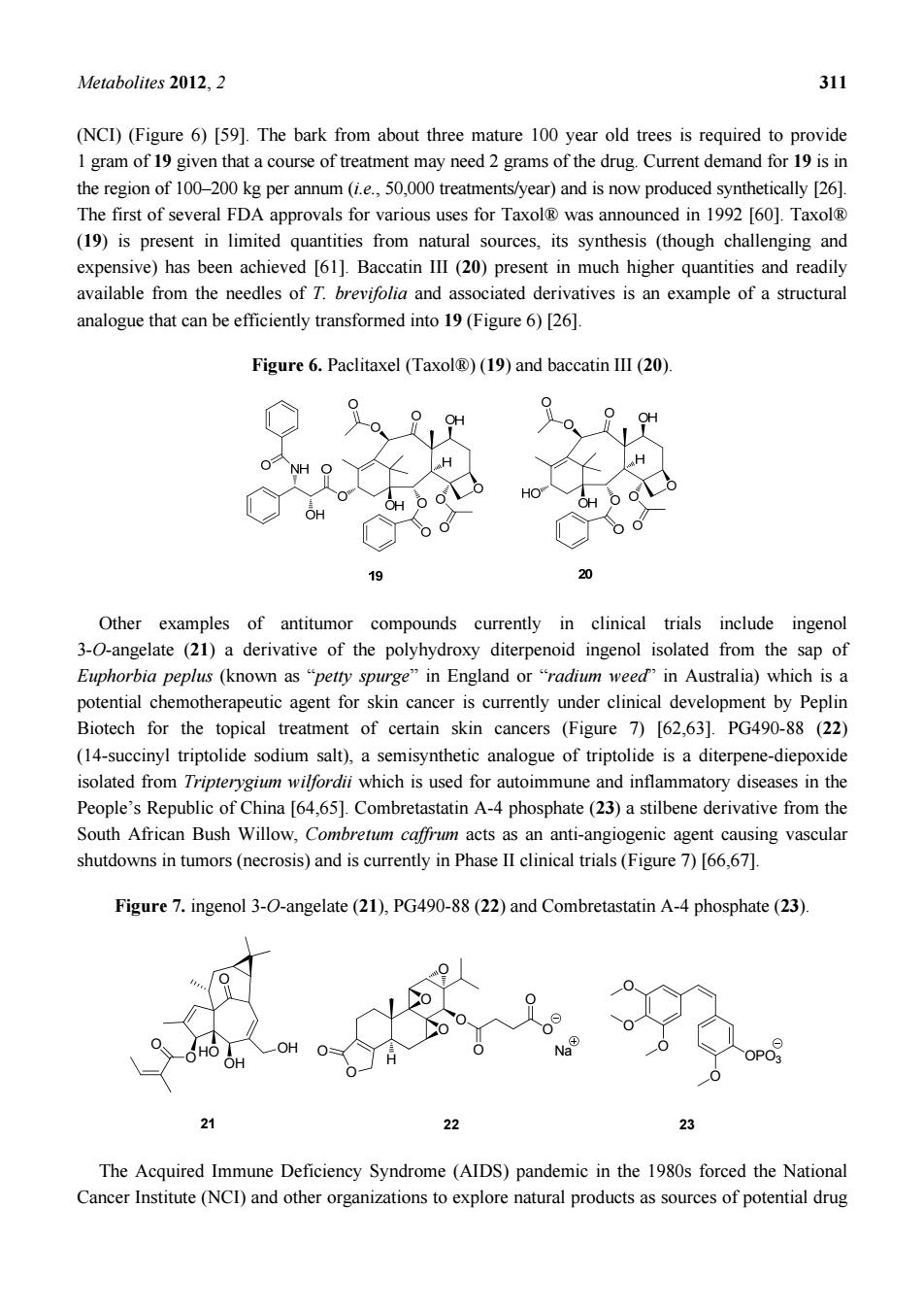正在加载图片...

Metabolites 2012.2 311 (NCI)(Figure 6)[59].The bark from about three mature 100 year old trees is required to provide I gram of 19 given that a course of treatment may need 2 grams of the drug.Current demand for 19 is in the region of 100-200 kg per annum (i.e.,50,000 treatments/year)and is now produced synthetically [26]. The first of several FDA approvals for various uses for Taxol was announced in 1992 [60].Taxol (19)is present in limited quantities from natural sources,its synthesis(though challenging and expensive)has been achieved [61].Baccatin III(20)present in much higher quantities and readily available from the needles of T.brevifolia and associated derivatives is an example of a structural analogue that can be efficiently transformed into 19(Figure 6)26. Figure 6.Paclitaxel (Taxol)(19)and baccatin III(20). 0 H 19 Other examples of antitumor compounds currently in clinical trials include ingenol 3--angelate (21)a derivative of the polyhydroxy diterpenoid ingenol isolated from the sap of Euphorbia peplus(known as "petty spurge"in England or"radium weed'in Australia)which is a potential chemotherapeutic agent for skin cancer is currently under clinical development by Peplin Biotech for the topical treatment of certain skin cancers (Figure 7)[62.63].PG490-88(22) (14-succinyl triptolide sodium salt),a semisynthetic analogue of triptolide is a diterpene-diepoxide isolated from which is used for autoimmune and inflammatory diseases in the People's Republic of China [64,65].Combretastatin A-4 phosphate(23)a stilbene derivative from the South African Bush Willow,Combretum caffrum acts as an anti-angiogenic agent causing vascular shutdowns in tumors(necrosis)and is currently in Phase II clinical trials(Figure 7)[66.67]. Figure 7.ingenol 3-0-angelate(21),PG490-88(22)and Combretastatin A-4 phosphate(23) 21 The Acquired Immune Deficiency Syndrome (AIDS)pandemic in the 1980s forced the National Cancer Institute(NCI)and other organizations to explore natural products as sources of potential drug Metabolites 2012, 2 311 (NCI) (Figure 6) [59]. The bark from about three mature 100 year old trees is required to provide 1 gram of 19 given that a course of treatment may need 2 grams of the drug. Current demand for 19 is in the region of 100–200 kg per annum (i.e., 50,000 treatments/year) and is now produced synthetically [26]. The first of several FDA approvals for various uses for Taxol® was announced in 1992 [60]. Taxol® (19) is present in limited quantities from natural sources, its synthesis (though challenging and expensive) has been achieved [61]. Baccatin III (20) present in much higher quantities and readily available from the needles of T. brevifolia and associated derivatives is an example of a structural analogue that can be efficiently transformed into 19 (Figure 6) [26]. Figure 6. Paclitaxel (Taxol®) (19) and baccatin III (20). Other examples of antitumor compounds currently in clinical trials include ingenol 3-O-angelate (21) a derivative of the polyhydroxy diterpenoid ingenol isolated from the sap of Euphorbia peplus (known as “petty spurge” in England or “radium weed” in Australia) which is a potential chemotherapeutic agent for skin cancer is currently under clinical development by Peplin Biotech for the topical treatment of certain skin cancers (Figure 7) [62,63]. PG490-88 (22) (14-succinyl triptolide sodium salt), a semisynthetic analogue of triptolide is a diterpene-diepoxide isolated from Tripterygium wilfordii which is used for autoimmune and inflammatory diseases in the People’s Republic of China [64,65]. Combretastatin A-4 phosphate (23) a stilbene derivative from the South African Bush Willow, Combretum caffrum acts as an anti-angiogenic agent causing vascular shutdowns in tumors (necrosis) and is currently in Phase II clinical trials (Figure 7) [66,67]. Figure 7. ingenol 3-O-angelate (21), PG490-88 (22) and Combretastatin A-4 phosphate (23). HO O O OH O OH 21 O O O O OPO3 23 O O O O O H O O O O Na 22 The Acquired Immune Deficiency Syndrome (AIDS) pandemic in the 1980s forced the National Cancer Institute (NCI) and other organizations to explore natural products as sources of potential drug